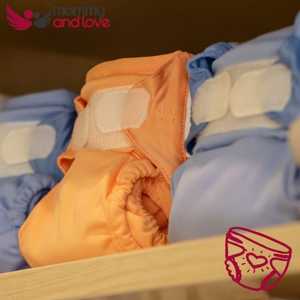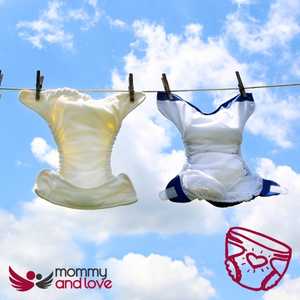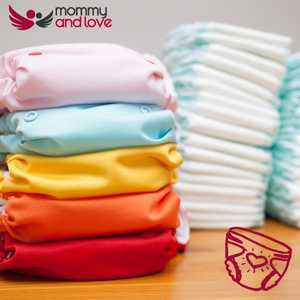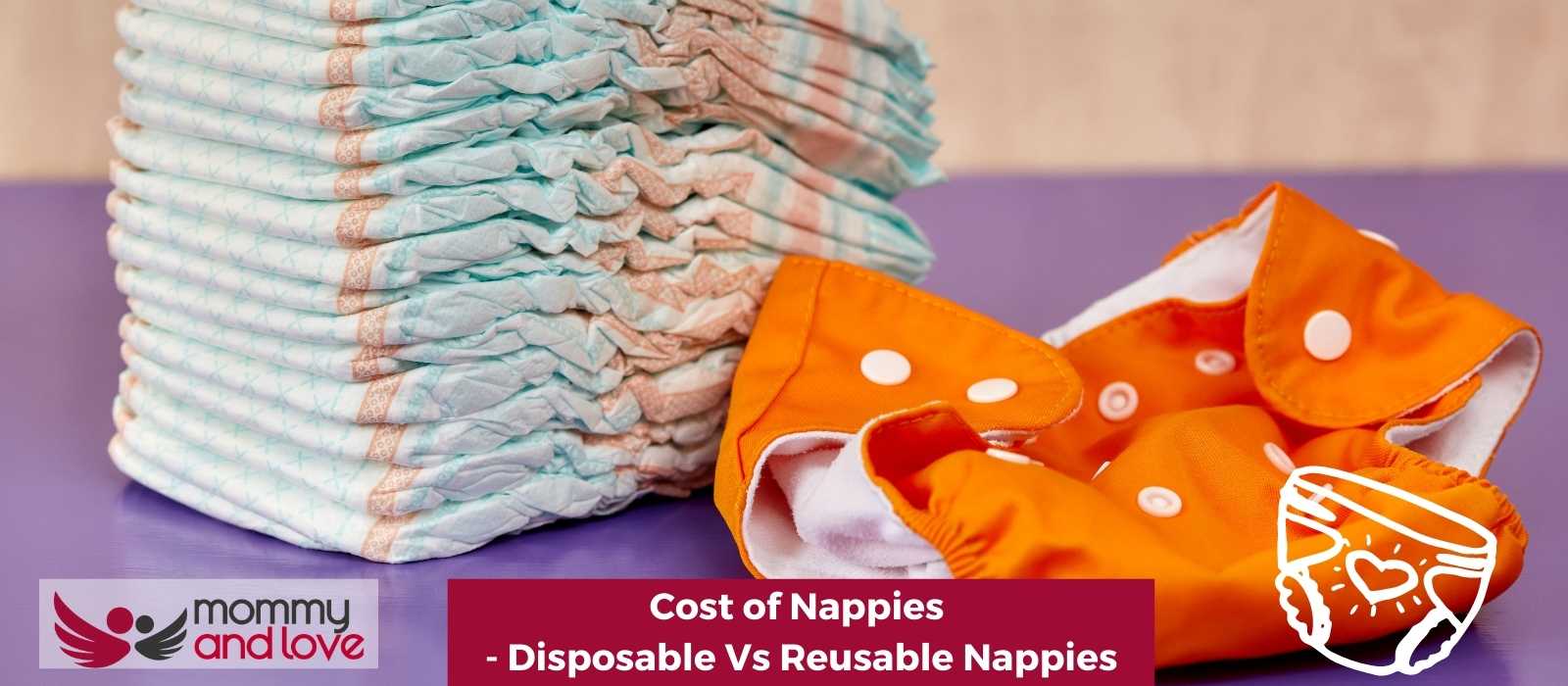We are all aware that swapping to real nappies can be hugely beneficial to the environment, but many parents are shocked at the amount of money that can be saved by swapping. Ultimately, the cost will depend on the nappy type you choose.
Not only are there a huge amount of budget friendly options on the market, it’s also easy to pick up cloth second hand, further enhancing the benefits.
How Much Do Reusable Nappies Cost?

Babies need on average 4000 nappy changes from birth to toilet training at around 2.5 years, that’s potentially a lot of disposable nappies going to landfill- and lots of money spent too.
The average cost of washable nappies will be around £400.
How Much Do Disposable Nappies Cost?
The average cost of disposable nappies to see your baby through to potty training is £1875. So you can save a whopping £1475 by swapping! We’ve done a detailed guide on the cost of disposable diapers here.
Your savings will be greater if you pick up nappies second hand, or free from other parents.
Are Cloth Diapers Better for the Environment, Your Wallet or Your Baby?

Parents make the swap for all kinds of reasons, and you’ll find that there are benefits to the environment, your budget and indeed for your baby!
The benefits to the environment and your pocket are optimal if you buy second hand nappies- these are easily sanitised ready to be used on your little one. Alternatively, buy one set and reuse for future babies of your own.
Once you’ve swapped the benefits to your baby’s skin can be dramatic, with a reduction in nappy rash. You have so much more control over what contacts your baby’s sensitive skin. Cloth bum toddlers are thought to potty train earlier than their peers who use disposables.
Are Reusable Nappies Better Than Disposable Ones?
Ultimately, that really depends on your own circumstances!
Reusable nappies won’t suit every family but are worth considering. There’s a huge selection available, so look at all the reusable nappies out there to get the system to suit best.
Check if your council offers a nappy laundry service, this will reduce costs and effort. The bottom line is that modern cloth nappies are effective, easy to use and environmentally friendly. We’ve also done a detailed post on why you should use cloth nappies.
Reusable Nappies Vs Disposable Nappies

Even biodegradable disposables take years to decompose in landfill, so many local councils within the UK offer incentives to promote reusables.
Reusable nappies are a cheaper alternative to regular disposables, as well as taking the pressure off landfill.
Even when you factor in laundry, the production and use of cloth nappies consumes less water than is used in the production of disposable nappies. Wash at 40 to reduce electricity and laundry costs! There is also less transport and fuel required, since there’s no need for constant trips to and from your store each week.
Cloth nappies are more breathable than disposables, with natural fibre options available, preventing nappy rash and fungal infection.
How Many Reusable Nappies Do I Need?
You will need approximately 25 if you plan on using reusable nappies from birth. You could need less if you use them part-time or if you are using for older children .
Modern cloth nappies come in many shapes and sizes- if you’d like to minimise the number you need, go for a quick drying, two part system and wash 3 times a week- for example, 5 waterproof wraps that can be wiped down between uses, and a set of 15-20 quick drying, cotton prefolds. If you can wash and dry quickly, you can get away with having fewer, reducing the cost!
How Do Reusable Nappies Work?
There are lots of different types of real nappy, but a cloth nappy typically has a waterproof wrap and an absorbent part.
All in one nappies have all the wrap and inserts stitched together, so the nappy goes straight on to your baby similar to a disposable nappy. Other nappies feature an absorbent insert made of cotton, hemp or bamboo which is folded in to a pad and placed inside the wrap. These are often very cost effective, you need less so will spend less. Some wraps feature a fleece lining, and a pocket in to which inserts are placed- these are called pocket nappies.
How Many Nappies Does a Baby Use in a Lifetime?
On average, from birth to around 2.5 years, a baby will go through around 4000 disposable diapers, and thousands of disposable wipes too. Which makes for a whole lot of landfill waste, and a spend of well over £2000!
On the other hand, around 25 reusable nappies and a similar number of cloth wipes will typically see your baby through costs £100-300 typically. Some councils offer a nappy washing service which makes life a little easier and reduces the cost too. We have a detailed guide to how many reusable nappies you will need.
What Should I Buy When I’m Expecting a Baby?
Real nappies are an upfront cost but can save you money. It’s well worth looking in to what’s available while you are expecting, you can also contact your local cloth nappy library for advice or try a cloth nappy trial pack. Don’t buy without doing some research first! Once you’ve found the best reusable nappies, a nappy pail and baby wipes, you are set up.
Isn’t Washing Nappies Expensive?
Even factoring in electric for the washing machine, you will still be saving money. You will even save money potty training as you can use potty training washable pants and pull ups instead of disposables until potty trained.
If you avoid tumble drying then your washing costs are much lower, and heere is our guide to drying reusable nappies. You will save with one child but if you use for future children, they work out cheaper again- and its one less new baby cost to worry about! Again you can wash your nappies with other clothes.
Maternity and Paternity Leave
It’s not just for mum! As long as your partner was on the company’s jobs for seven months you could apply for paternity leave on at least £151.20 per week. Shared parent leave allows couples to take 50 weeks of their leave prior to their child’s birthday.
Some employers pay in full for the past two fortnights therefore check before you go. Sharing parental leave keeps you both equally involved.
How Do Cloth Nappies Save Money?
You can get second-hand reusable nappies discounted or even free from other mums. You can even resell them to smaller children once your child grows out of them so you can reduce costs even more. Freecycle, Gumtree and community Facebook groups are great resources for this! Advice on reusable nappies is widely available either from local government or local community groups.
Many local councils give grants due to the huge environmental impact so it’s a good idea for new parents should always look for local grants in their area which will make the switch even more cost effective. The average number of nappies used in 2.5 years is 4000, and those take 500 years to decompose- of all the things we can do to help our planet this is the easy one!
How Much Do Nappies Cost?
Most estimated total cost of washable nappies is between £150-300 per child. Using a birth to potty system and reusing or reselling maximises savings- buying second nappies had can half the price. The average parent meanwhile will spend upwards of £1800 on disposable nappies.
Landfill Costs of Disposables
The U.K. annually dumps 3 billion disposable nappies at landfills. Every year councils aim at reducing landfill waste because they pay per tonne in landfill tax and other costs- which is why many councils offer incentives to swap to reusables.
Equipment
You will need little different than you would using disposable nappies- just an efficient washing machine, along with reasonable drying facilities. A nappy pail, washable nappy bags for out and about and perhaps cloth wipes and liners will be helpful and very eco friendly. In the early days, a pack of disposables can handy to have on hand while you recover.
Local Authority Incentives
Some local authorities in Britain offer a nappy voucher for up to £50.00 or a free sample starter kit. The application process and availability of support will vary depending upon your city of residence so ask local authorities what help is available! We’ve done a full guide to council grants for reusable nappies.
Reusable and disposable nappies and Childcare
Childcare facilities won’t wash diapers, but are usually more than happy to use the nappy that the parents prefer. Soiled reusables will be stowed away and sent home for washing. And, the bonus is that the savings made by using reusables, will help offset the expense of day care! Read out guide to cloth nappies in childcare.
Negatives
For most parents, the main negative is that reusables require more effort, also, not every family can afford the upfront costs. It can be hard to get it right, especially for heavy wetting toddlers. Newborns use lots of nappies, so reusables can be extra work in the early days. Half the battle can also be convincing friends and family!
Positives
You can save money, protect your little one’s skin, and do your bit for the environment over the two and a half years yous baby is in nappies There are also lots of pretty prints and styles available.
The Verdict
There are many ways to offset the costs associated with cloth nappies, making the savings huge compared to the average cost of using disposables. Most people have A+ washing machines, and you do not need to wash at 60 degrees every time. The benefits to your baby, your budget and the environment outweigh the negatives!
Be sure to research what may be the best solution for your family.

This article was written by: Gian MIller – Full-Time Writer, Baby Whisperer & Dad of 3.
Gian spends a lot of his time writing. A self-proclaimed baby whisperer, Gian has been through it all with his own children and is passionate about sharing his hard-won wisdom with other parents. When he’s not writing or changing diapers, you can find him playing the guitar or watching baseball (or preferably both at the same time).




